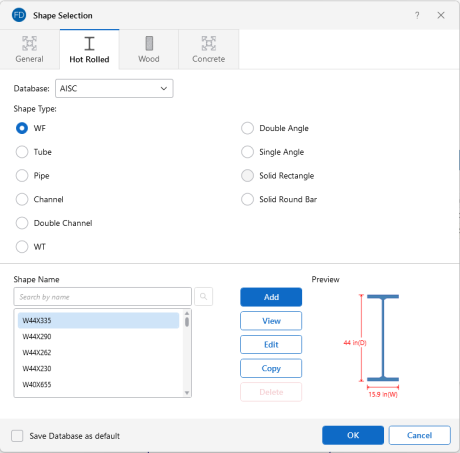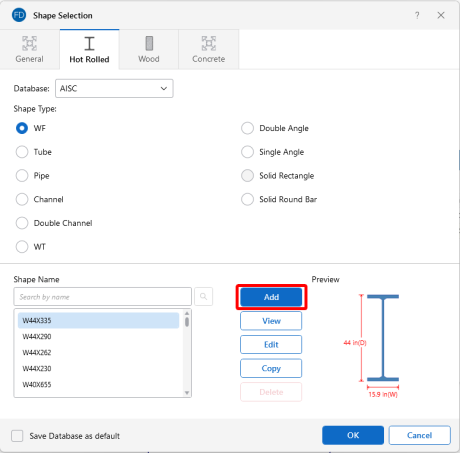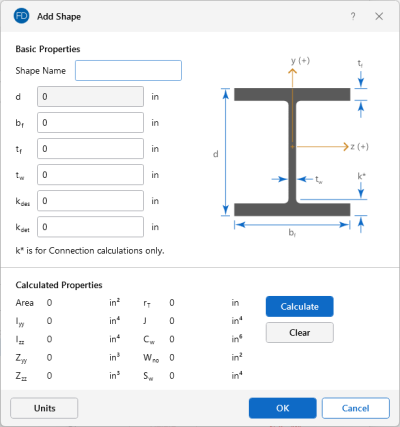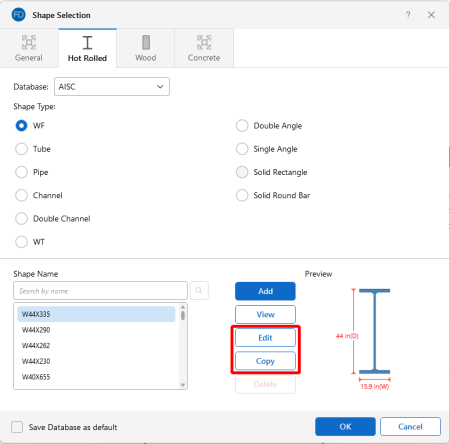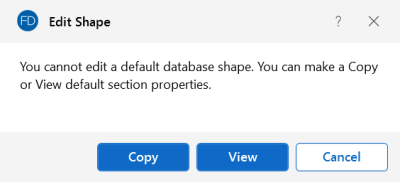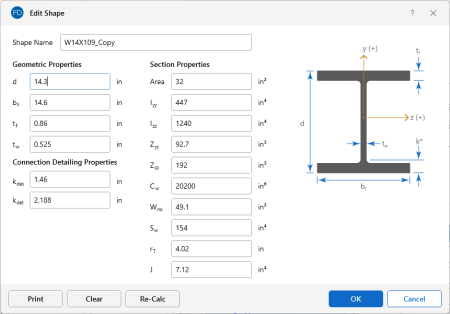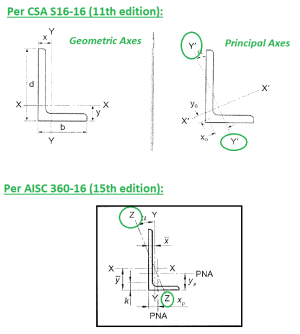Hot Rolled Steel - Databases
Shapes are organized by Shape Type and Database / Manufacturer. Common shapes are supported such as; wide flanges, tubes, pipes, channels, etc. You can type in the names directly, select shapes from these databases or add your own shapes.
RISA currently supports the following common Hot Rolled steel databases: AISC (United States), Australian, British, Canadian, Chilean, Chinese, European, Indian, Korean and Mexican.
Select a Database Shape
To select a Hot Rolled Steel database shape for pile elements:
-
Click the
 ellipsis button in the Shape column of the Pile Definitions Spreadsheet to open the Shape Selection dialog.
ellipsis button in the Shape column of the Pile Definitions Spreadsheet to open the Shape Selection dialog. -
Click on the Hot Rolled tab.
-
Choose the appropriate Database.
-
Choose the Shape Type. See Available Database Shapes for more information on shape types.
-
In the Shape Name list, find and select the shape you want to use.
-
Click OK to save your selection, close the window, and return to the spreadsheet.
-
The chosen shape is displayed in the Shape cell of the spreadsheet.
Click on image to enlarge it
Add a Database Shape
To add a Hot Rolled Steel database shape:
-
On the Advanced ribbon, click the Shape Database icon.
Click on image to enlarge it
The Shape Selection window opens.
Click on image to enlarge it
- Click on the Hot Rolled tab.
-
Choose the Database and Shape Type you wish to add.
See Available Database Shapes for more information on shape types.
-
Click the Add button.
The Add Shape window opens.
Click on image to enlarge it
- Under Basic Properties, specify a Shape Name for the shape and fill in the basic properties.
- Click the Calculate button to determine the shape properties.
-
Click OK to accept the new shape and close the Add Shape window.
The new shape is added to the bottom of the Shape Name list in the Shape Selection window.
Edit a Database Shape
To edit a Hot Rolled Steel database shape:
-
Go to the Advanced ribbon.
-
Click on the Shape Database icon in the Libraries section.
Click on image to enlarge it
The Shape Selection window opens.
Click on image to enlarge it
- Click on the Hot Rolled tab.
- From the Shape Name list, choose the shape you wish to modify and click Edit.
-
If the Edit Shape window opens stating that you cannot edit the default database shape, click Copy.
Click on image to enlarge it
You will be able to edit the copy after you provide a new name, click the Copy Shape button, and answer the question as to whether or not to make the shape available for all models.
-
Select the copied shape which has been placed at the bottom of the Shape Name list and click the Edit button.
The shape copy opens in the Edit Shape window, as shown in the following example.
Click on image to enlarge it
-
Make whatever changes are needed by either:
-
Manually inputting the Geometric Properties and Section Properties.
-
Having the program calculate the Section Properties based on values you input for the Geometric Properties.
Once an edit is made to the Geometric Properties or to both the properties, you’ll need to run a recalculation.
-
- Click the Re-Calc button to have the program calculate the new Section Properties automatically.
- Click OK to save the newly calculated, edited shape.
-
Do one of the following in the Changes to Shape Database window that appears:
-
Click Yes if you want the changes to apply to all new models created on your computer.
-
Click No if you want the changes to apply ONLY to the current model.
-
- New shapes are added to the bottom of the database list in a blue font to show they were not originally part of the default database.
- To delete a shape, specify the database and shape type you wish to delete and then click the Delete button.
- Only shapes added to the default database (shown in blue) are able to be edited or deleted.
Available Database Shapes
Wide Flange Database Shapes
For the AISC database, wide flange shapes are called out by the designation given to them in the steel manuals. For example, if you wanted to use a W10x33, you would enter W10X33 as the shape name in the Database Shape field. M, S and HP shapes are also available. Trade Arbed shapes are called out similar to AISC shapes, but with a "_ARB" suffix. To call a Trade Arbed W12X96, you would enter W12X96_ARB as the shape name in the Database Shape field. Canadian and British shapes use the same format as the AISC shapes, but their values are metric. The depth is called out in millimeters and the mass per length is kg/meter.
Tube Database Shapes(Hollow Rectangular shapes)
The HSS tube properties are also available in the AISC database. The prefix for these tube shapes is "HSS". The syntax is "HSSdepthXwidthXthick", where "depth" is the tube depth, "width" is the tube width and "thick" is the tube thickness in number of 1/16ths. The nominal wall thickness is always used to call out a HSS tube, even though the design wall thickness will vary based on the manufacturing process for the tube. Tubes manufactured using the ERW process will use .93 times the nominal wall thickness as their design thickness. Tubes manufactured using the SAW process will use the full nominal thickness as their design thickness. For example, an HSS12X10X8 would be a 12" deep, 10" wide tube and a have a design wall thickness of .465" = .93*1/2" (8/16ths). An HSS32X24X10 would be 32" deep by 24" wide, and have a design wall thickness of 5/8" (10/16ths)
For the Canadian database, tubes also have an "HSS" prefix and the dimensions are all called out in millimeters. British shapes use the prefix “SHS” for square tubes and “RHS” for rectangular tubes.
- The prefix for older AISC tube shapes is "TU". These shapes reflect the properties that were published with the older AISC 9th edition. As such, these shapes may only exist in the AISC_backup database.
- Tubes using the TU prefix will have a design wall thickness of the nominal wall thickness. The syntax is "TUdepthXwidthXthick", where "depth" is the tube depth, "width" is the tube width and "thick" is the tube thickness in number of 1/16ths. For example, TU16X12X8 would be a 16" deep, 12" wide tube with a thickness of 1/2" (8/16ths).
Pipe Database Shapes
Pipe shapes, which are hollow circular shapes, are entered as on-line shapes. The syntax for these shapes is "PIdiaXthick", where "dia" is the pipe outside diameter and "thick" is the pipe thickness (in inches or centimeters). For example (assuming US Standard units), PI10X.5 would be a 10" diameter pipe with a wall thickness of 1/2".
Channel and Double Channel Database Shapes
Channel shapes are entered with the "C" or "MC" prefix. For example, C15X50 would be a valid entry. For Canadian and British shapes, the depth is called out in millimeters and the mass per length is in kg/meter. Double channels are entered with the “2C” or “2MC” prefix.
Tee Database Shapes
The Tee shapes are entered with the "WT", "MT" or "ST" prefix. For example. WT15X74 would be a valid entry. For Canadian and British shapes, the depth is called out in millimeters and the mass per length is in kg/meters.
Double Angle Database Shapes
These shapes are entered with the prefix "LL". The syntax is "LLbackXflangeXthickXspace" where "back" is the back to back leg length, "flange" is the single angle flange leg length, "thick" is the angle thickness in number of 1/16ths and "space" is the space between the angles in 1/8ths. For example, "LL6X3.5X5X3" would be L6X3.5 angles that are 5/16" thick, long legs back to back with a spacing of 3/8". For the Canadian and British shapes, all the dimensions are called out in millimeters.
Single Angle Database Shapes
Angles are entered with an "L" prefix. The syntax is "LlongXshortXthick", where "long" is the long leg length, "short" is the short leg length and "thick" is the thickness, in number of 1/16ths. For example, L9X4X8 is a 9" by 4" angle that is 1/2" (8/16ths) thick. For the Canadian and British shapes, all the dimensions are called out in millimeters.
Click on image to enlarge it
Solid Rectangle Shapes
These shapes can be defined as on-line shapes. The syntax is "REhtXbase", where "ht" is the rectangle height and "base" is the rectangle base (in inches or cm). For example, RE10X4 would be a 10" deep, 4" width rectangular shape (assuming US Standard units). These shapes can also be defined in the Shape Editor. When defined in the Shape Editor, the depth of the solid rectangular section must always be greater than or equal to the width.
Solid Round Bar Shapes
These shapes are defined as on-line shapes. The syntax is "BARdia", where "dia" is the circle diameter. For example (assuming metric units), BAR2 would be a circular bar with a diameter of 2 cm.
